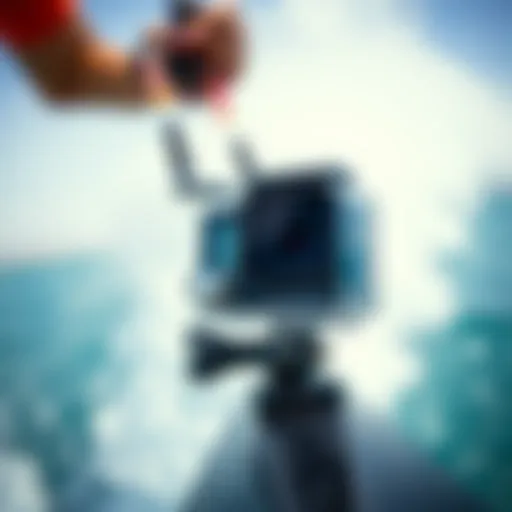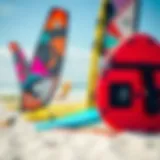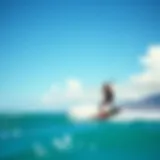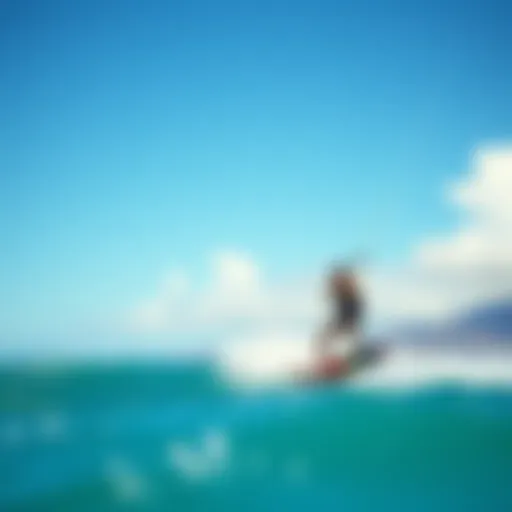Finding Kitesurfing Classes Near You: A Guide
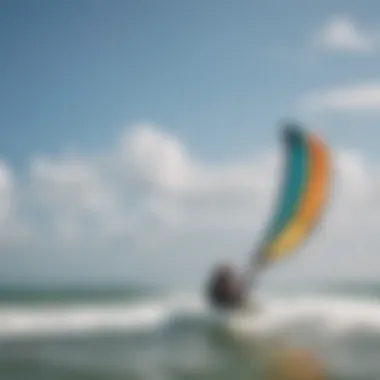

Intro
Kitesurfing has grown in leaps and bounds over the last few decades, transforming from a fringe sport into a global phenomenon. While the thrill of gliding over the water, harnessing the wind to propel oneself, is undeniable, the journey to becoming proficient can be daunting. For those considering diving into this adrenaline-pumping activity, taking classes is a vital step towards mastery.
In this piece, we’re going to navigate the winding path of finding kitesurfing classes in your area. We’ll discuss the different categories of lessons available, delve into the qualifications of instructors, and examine local weather conditions that can make or break your kiteboarding experience. Additionally, we will cover safety protocols that every beginner should be aware of. Moreover, we will consider the social fabric surrounding the sport, exploring how the kiteboarding community enriches your learning journey.
Whether you are a curious traveler or a local adventurer, this guide aims to equip you with the knowledge to make informed decisions regarding kitesurfing lessons. Buckle up and prepare for takeoff!
Gear Insights
When it comes to kitesurfing, having the right gear can be as critical as the lessons themselves. The equipment you choose not only affects your performance but also significantly impacts safety. Below, we’ll take a closer look at essential gear as well as some trending products in the kiteboarding market.
Latest Gear Reviews
Kitesurfing gear is constantly evolving, with new innovations hitting the shelves every season. For instance, brands like Duotone have captured attention with their advanced kite models designed for various skill levels. The latest addition, the Duotone Rebel 2023, offers remarkable wind range and stability, making it a favorite among experienced riders and newcomers alike.
Another noteworthy mention is the Brunotti kites that are gaining popularity for their durability and flexibility. Users have reported enhanced responsiveness, giving that extra edge needed during tricky maneuvers. Investing in reputable brands can seem pricey but is often justified by the longevity and performance of the gear.
Essential Gear for Beginners
For those just starting, here’s a list of must-have gear:
- Kite: Start with a medium-sized kite, typically 9-12 meters, suitable for a wide range of wind conditions.
- Board: A twin-tip board is a solid choice for beginners as it allows riding in both directions.
- Harness: A comfortable harness is essential. Look at options like seat or waist harnesses based on your preference.
- Safety Leash: This keeps the kite attached to you, preventing accidental loss in the water.
- Impact Vest: While it may not be compulsory, an impact vest can provide an extra layer of protection.
Before you make a purchase, it might be worth checking out local gear shops or rental options. Many schools provide gear for their lessons, so testing out different equipment can guide your buying decisions later on.
Techniques and Tips
Once you have the right gear in hand, learning the tricks of the trade becomes the focus. Just as the gear varies, so does the technique.
Advanced Tricks and Techniques
For those who find their feet under them and wish to progress, understanding advanced techniques is key. Tricks such as the backroll or kite loop add flair to your ride and are often built upon foundational skills. Each maneuver requires a mix of timing, control, and a bit of courage.
Safety Practices for Kiteboarders
Safety cannot be stressed enough in the world of kitesurfing. Here are some crucial practices every kiteboarder should adopt:
- Check Weather Conditions: Always assess wind speed and tides before heading out.
- Buddy System: Practice with a partner, not only for safety but also for collective learning.
- Emergency Procedures: Familiarize yourself with quick release mechanisms and how to signal for help in distress.
- Know Your Limits: It’s easy to get carried away, but taking on conditions beyond your skill level can lead to accidents.
Engaging with the local kiteboarding community can also enhance your understanding of safety protocols. Discussions on platforms like Reddit can provide real-life insights and recommendations.
“Kitesurfing is not just about the thrill; it's about understanding the elements and respecting them.”
In wrapping up, finding the right kitesurfing classes in your area is just the first step on your adventure. With the correct gear and techniques, along with an emphasis on safety, you'll find yourself not only enjoying the sport but also becoming a part of a vibrant community. Whether you’re aiming for the high seas or just catching some local wind on a calm river, the kitesurfing journey awaits.
Preamble to Kitesurfing
Kitesurfing is not just a sport; it's an experience that combines the thrill of surfing, the excitement of wind, and the serenity of being on the water. Understanding the basics and the history of this exhilarating activity is essential for anyone looking to dive in. In this article, we aim to lay a solid foundation for your kitesurfing journey by exploring its core aspects. Whether you’re a curious newbie or an experienced traveler searching for kitesurfing classes near you, this section serves as your launching pad.
The Basics of Kitesurfing
At its core, kitesurfing involves riding on a board while being pulled along by a large kite. The kite is controlled by the rider using a series of lines and a harness. Practicing the basics includes learning how to set up the equipment, control the kite, and harness the wind effectively. It's vital to grasp the mechanics, as the foundation you build during the initial stages will dictate your ability to advance in the sport.
Key components to consider:
- The Kite: Varies in size and shape, each designed for different wind conditions and styles.
- The Board: Comes in various types like twin tips and directional boards, catering to different riding techniques.
- Safety Gear: Helmets, impact vests, and harnesses are essential for minimizing risks.
Learning these basics not only heightens your safety during practice but also enhances your enjoyment as you master the wind and waves.
History of the Sport
The roots of kitesurfing can be traced back to various forms of kite flying and surfing, evolving significantly since its inception. The early iterations date back hundreds of years, but the modern form really began to take shape in the late 20th century. In the mid-1970s, innovators experimented with using inflatable kites for water sports, paving the way for what we see today.
In the 1990s, kitesurfing exploded in popularity. As more enthusiasts hit the water, professional organizations began to emerge, providing regulation and structure. The introduction of safer kites, improved equipment, and standardized instructional methods has made the sport more accessible to a wider audience.
Taking time to understand kitesurfing's history not only enriches your experience but connects you to the community of passionate riders across the globe. From its humble beginnings to its current status as a mainstream sport, kitesurfing embraces a spirit of adventure and exploration that resonates with many.
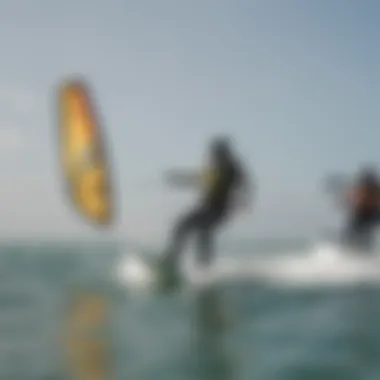

Understanding Kitesurfing Classes
Diving into kitesurfing classes is more than just a necessity for beginners; it can be essential for seasoned veterans looking to advance their skills. Understanding what these classes offer helps prospective kiteboarders find the right fit that meets their aspirations. Navigating through the variety of available courses—whether private instruction or group sessions—can significantly influence your kitesurfing journey.
Types of Classes Offered
Kitesurfing schools around the world offer an array of class options tailored to various skill levels and preferences. Let's break down the primary types.
One-on-One Instruction
In essence, one-on-one instruction is akin to having a personalized coach at your disposal. This type of lesson focuses specifically on the individual’s needs. The intimate setting allows instructors to tailor their teaching style to the learner’s pace, addressing specific challenges or goals. Ideal for beginners who might feel overwhelmed in a group or for advanced practitioners keen to refine particular techniques, this approach is often deemed a beneficial option.
The unique feature of one-on-one instruction is its flexibility. You can dive into sessions at your convenience and cover topics that directly resonate with your growing interests. However, this can come at a steeper cost compared to group classes.
Group Classes
Group classes act as the social butterfly of kitesurfing lessons. Imagine sharing the thrill of your first ride alongside a bunch of fellow enthusiasts. This communal environment can foster camaraderie, as beginners learn from one another's triumphs and challenges. Often more affordable than private lessons, group settings can also recreate real-world scenarios where kiteboarders may find themselves riding alongside others.
One of the key characteristics of group classes is their dynamic learning environment. While the guidance may not be as personalized, participants are often encouraged to engage with their peers, creating a shared experience that can be equally rewarding. It’s worth noting, though, that individual attention might be spread thin among participants, potentially delaying progress for some.
Advanced Techniques Workshops
For those who have acquired the basics and are eager to push their boundaries, advanced techniques workshops are a gateway to new skills and tactics. These workshops often target specific areas, such as jumping, tricks, or wave riding, offering in-depth instruction aimed at specialized skills.
What makes these workshops stand out is their concentrated focus on mastery. Participants often leave with enhanced skills and a deeper understanding of their equipment and conditions. Although they may require a certain level of proficiency, the rewards can be immense for those serious about elevating their game.
Benefits of Taking Classes
Engaging in kitesurfing classes is not merely about learning the ropes—there’s a wealth of benefits that fundamentally enrich your experience.
Skill Development
Skill development is the heart of what kitesurfing classes aim to achieve. From the initial stages to advanced maneuvers, every lesson is meant to build upon previous knowledge and experience. This structure is particularly effective because it ensures that each learner is not only progressing but also developing a solid foundation.
The beauty of this structured development is its progression. As skills enhance, confidence grows, making future challenges seem less daunting. On the flip side, lacking proper instruction can lead to bad habits that are oftentimes frustrating to unlearn as you advance.
Safety Awareness
Safety awareness can’t be stressed enough in kitesurfing, a sport that comes with its fair share of risks. Taking classes ensures that you not only learn technical skills but also the rules of the water and safety protocols. Instructors emphasize understanding weather patterns, equipment checks, and rescue techniques, which are crucial for a safe experience.
One remarkable element of this safety focus is how it instills a culture of responsibility amongst kiteboarders. When every participant understands the importance of safety, it elevates the overall experience for everyone on the beach.
Enhancing Enjoyment
Ultimately, enhancing enjoyment is the cherry on top of taking kitesurfing classes. As you develop skills and safety awareness, the very act of kiteboarding transforms from a stressor into a source of pure exhilaration. Being well-prepared mitigates anxiety, allowing you to focus solely on enjoying the ride.
This translates into a more fulfilling experience out on the water, where you can truly relish the beauty of kitesurfing without fearing the unknown. However, on the downside, those who skip lessons may find themselves frustrated due to preventable mishaps or feeling stranded in their skill set.
Finding Kitesurfing Classes Near You
Searching for kitesurfing classes nearby is a pivotal entry point into this thrilling sport. Whether you’re a novice hoping to learn or a seasoned rider looking to refine your skills, knowing where to find quality instruction is essential. The right class can significantly enhance your understanding of the sport and boost your safety on the water. Using local resources effectively and tapping into community insights can make all the difference.
Online Resources and Platforms
In today's digital age, the internet is a treasure trove of information, especially when it comes to kitesurfing classes. Websites like Facebook, Reddit, and specialized kitesurfing forums are buzzing hubs where enthusiasts share their experiences. You can find local reviews, firsthand accounts, and even recommendations for the best instructors.
Additionally, dedicated kitesurfing websites often feature directories of instructors categorized by location. Here are some pointers on how to leverage online platforms:
- Search for reviews: Aim for platforms that allow users to rate and review their experiences with schools and instructors. This feedback is invaluable.
- Explore social media: Participating in groups on platforms like Facebook can connect you with other kitesurfers who might provide leads or even recommendations based on your specific needs.
- Use search engines: Simply typing in "kitesurfing classes near me" can yield a variety of results including local schools, instructors, and customer reviews to guide your choice.
Local Kiteboarding Schools and Instructors
Nothing beats face-to-face interaction, so seeking out local kiteboarding schools is a smart move. These schools not only provide lessons but also foster a community of like-minded individuals passionate about the sport. When searching for a local school, consider the following:
- Check the certifications: Make sure the instructors are certified by recognized organizations. This ensures that you’re learning from professionals who are trained in safety and best practices.
- Look for variety in instruction: Some schools specialize in specific types of classes or age groups. If you're looking for a beginner course, make sure the school offers tailored programs for novice riders.
- Visit the location: If possible, drop by the school to get a feel of the environment. Speak with the instructors, check the conditions of the equipment, and understand the local culture around the sport.
"The best learning often happens when you immerse yourself in a community that shares your passion."
Community Recommendations and Reviews
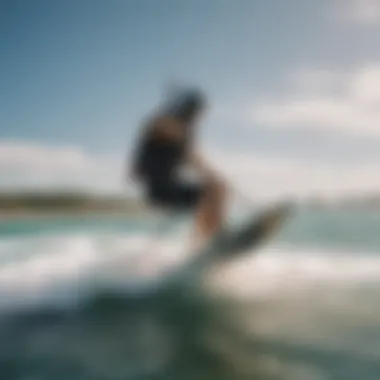

Word-of-mouth is a powerful tool when it comes to selecting a kitesurfing class. Engaging with the local kitesurfing community can lead you to hidden gems that online searches may overlook. Seek recommendations from fellow enthusiasts at local beaches or kiteboarding events, as they often have valuable insights. Here’s how to tap into community knowledge:
- Join local groups: Many regions have clubs or groups dedicated to kitesurfing. These communities often hold events and are a great place to meet instructors and experienced riders.
- Attend workshops or meetups: Participating in local kitesurfing events may open doors to informal instruction opportunities or partnerships for your learning journey.
- Use online platforms wisely: Websites and forums sometimes have localized sections where users discuss local schools or instructors, so don’t hesitate to ask questions there.
Finding kitesurfing classes near you can be an exciting journey. With the right resources and community engagement, you can dive into a world that merges adventure with skill, all while ensuring a safer learning path.
Evaluating Local Conditions
Understanding local conditions is crucial when embarking on your kitesurfing journey. The interplay of wind, weather, and geographical features can profoundly affect the experience and safety of kitesurfing classes. Evaluating these conditions not only helps you determine the right time and place to learn but also enhances your overall skill development and enjoyment of the sport.
Wind and Weather Considerations
One cannot overstate the importance of wind in kitesurfing. For beginners, consistent winds are essential. If you're at a location where the wind plays hard to get, it can be frustrating to be all geared up and ready to ride, only to find the breeze isn't cooperating. Ideally, a steady wind of about 10 to 20 knots is perfect for learning. This range allows for enough lift without overwhelming a novice rider. Additionally, it's wise to keep in mind weather patterns; knowing the average wind conditions for the season will help you choose the best times to schedule classes.
"When the winds favor you, kitesurfing becomes an exhilarating dance with the elements."
Geographical Factors Impacting Classes
Geographical features like water conditions and coastal terrain are pivotal in shaping the kitesurfing experience, especially for learners. They determine how conducive an area is for handling a kite and managing a board in the water.
Water Conditions
Water conditions vary from flat to choppy, and each type presents its set of benefits and challenges. Flat water, such as that found in lagoons or certain bays, is often preferred for beginners. It allows for easier balance and control when you’re just starting to learn how to ride a board. Coupled with minimal waves, this environment provides a safer playground to practice basic skills like getting up on the board and navigating.
On the flip side, choppy water can make it tougher for newcomers to maintain balance. However, it also offers a unique challenge that can be exhilarating for those with some experience. Understanding the local water conditions can help students strategize their learning paths.
Coastal Terrain
The coastal terrain where you learn can influence your kitesurfing experience significantly. Sandy beaches are often the go-to because they provide a welcoming area for launching and landing kites. A smooth, wide beach means you can gather your gear and get started without tripping over rocky obstacles.
In contrast, rocky or uneven coastal areas can present additional risks, especially for those not yet fully confident in their kite control skills. Moreover, these environments might require additional precautions during lessons.
Overall, evaluating both wind and geographical elements ensures you're setting yourself up for a rewarding kitesurfing experience. The right conditions can turn what might initially seem like a daunting task into an enjoyable learning adventure.
Instructors' Qualifications
When seeking to engage in kitesurfing, a significant factor to consider is the qualifications of your instructors. Having a knowledgeable and skilled instructor can make the difference between a safe, enjoyable experience and a frustrating ordeal. Their qualifications not only indicate their expertise but also ensure that they adhere to safety standards, making your learning journey more secure and effective.
Certification and Training
In the world of kitesurfing, various organizations offer certification programs designed to equip instructors with the necessary skills. When looking for a class, inquire about the certifications your instructor holds. Well-recognized certifications often come from agencies such as the International Kiteboarding Organization (IKO) or the BritishKiteSportsAssociation (BKSA).
These programs prepare instructors through rigorous training in both practical and theoretical aspects of the sport. They cover teaching techniques, safety protocols, and often even weather conditions relevant to kitesurfing. You want someone who can diagnose your learning style. An instructor certified by IKO, for example, is trained to adapt their teaching methods to various skill levels and can respond effectively to your pace and needs.
In addition, it’s essential that instructors continually update their skills. Just like the newest smartphone model, there are always advancements in gear and safety protocols. Thus, choose instructors who participate in ongoing education. This shows a commitment to their profession and ensures their knowledge is current, enhancing the quality of your instruction.
Experience and Specializations
Experience in kitesurfing varies widely among instructors. A firm grasp of local conditions is vital, as kitesurfing often relies heavily on specific wind patterns and water conditions. An instructor well-versed in your local scene can provide invaluable insights. For instance, each coastal area has its own quirks; an instructor familiar with where to find the most reliable wind and how tides influence conditions will give you an edge in your learning.
Moreover, instructors may also have specializations that cater to different interests within the sport. Some might focus on freestyle tricks, while others may emphasize racing techniques. Understanding these specializations allows you to align your training with your goals—be it mastering jumps or perfecting speed. A conversation with potential instructors can reveal a lot about their styles and areas of focus, so don’t hesitate to ask questions.
In sum, the qualifications of your kitesurfing instructor are a cornerstone for a rewarding learning experience. Their certifications not only ensure safety and proper technique but also enrich your understanding of the sport. Combine this with experience and specializations, and you have a solid foundation for your kitesurfing journey. As the saying goes, "a skilled captain will sail a steady ship," so setting sail with qualified instructors can lead to smooth waters ahead.
Safety Practices in Kitesurfing
When stepping onto the water with a kiteboard, safety stands as a fundamental pillar of the sport. Engaging in kitesurfing offers exhilarating thrills, but it comes with its own set of risks that can’t be brushed aside. A comprehensive grasp of safety practices isn't just crucial; it can mean the difference between a day of fun and a trip to the hospital. From taking proper precautions to understanding your environment, the right safety measures enhance your kitesurfing experience while safeguarding your well-being.
Importance of Safety Briefings
Before hitting the waves, participating in a safety briefing is non-negotiable. These sessions, often led by your instructor, cover essential aspects of the sport, such as:
- Understanding Weather Patterns: Knowing how to read the wind and assess weather conditions is vital to prevent accidents. Inflated kites don’t mix well with lightning, not to mention sudden gusts that can catch even the talented rider off-guard.
- Emergency Procedures: Expedient actions can mitigate potentially dire situations. A solid briefing teaches you what to do if you encounter problems, like tangling your lines or transitioning into unexpected weather.
- Local Customs and Laws: Not every beach is kitesurfing friendly. Understanding regulations ensures you won’t end up in legal trouble while enjoying your ride.
In short, safety briefings lay the groundwork for a responsible kiting experience. They empower enthusiasts, rendering them informed participants rather than reckless adventurers.
"An ounce of prevention is worth a pound of cure"—this adage rings true in the world of kitesurfing.
Equipment Safety Checks
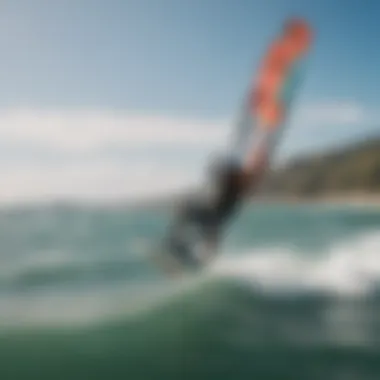

A kite without a proper equipment check is like sailing a ship with holes in the hull. Mechanics might seem drab compared to the adrenalin rush of riding the waves, but a careful examination of your gear prior to launching is paramount. Key considerations include:
- Kite Inspection: Look for any signs of wear, like frayed lines or punctured bladders. A tiny tear can enlarge quickly when under pressure, leading to failure at a critical moment.
- Harness and Safety Systems: These devices keep you connected to your kite. Ensure the harness fits snugly and the release mechanism works. Trusting faulty equipment can set you up for disaster.
- Safety Leash: This apparatus serves as a lifeline between you and your kite. If things go south, ensuring its reliability could save your life.
- Board Essentials: Check your board straps and fins. Loose or damaged components may not only throw off your balance but also result in unwanted accidents.
By committing to these essential safety checks, you're not just protecting yourself; you're also upholding the integrity of the sport and encouraging a culture of responsibility within the kitesurfing community.
Cultural Aspects of Kiteboarding
Kiteboarding isn't just a sport; it's a global phenomenon intertwined with diverse cultures and traditions. The cultural aspects of kiteboarding can significantly influence your experience, allowing you to connect with not just the sport itself, but also the communities that foster it. Understanding these elements can enhance your overall enjoyment and involvement in kitesurfing.
Regional Variations and Styles
One of the most fascinating perspectives in kitesurfing is how regional characteristics shape its practice. Different areas have their particular styles driven by local conditions, cultural history, and community preferences. For instance, in Brazil, you might find a vibrant style that focuses on freestyle tricks, fueled by strong winds and warm waters. Meanwhile, in a place like the Netherlands, kiteboarding takes on a more utilitarian approach, benefiting from the flat, expansive waters that offer unique challenges and experiences.
In places like Maui, Hawaii, the emphasis might shift toward big waves and harnessing the power of nature in its rawest form. Local riders adapt their techniques and gear choices based on these geographical realities, often tailoring their equipment to fit the conditions unique to their environment.
Furthermore, the cultural attitudes toward water sports can also shape kitesurfing practices. In some regions, it's a casual, laid-back activity suited for friends and families. In contrast, others may treat it like a competitive sport, organizing events and competitions that attract a wider audience.
Different styles that emerge from these variations are often celebrated within their communities, forming a kind of kinship among riders. As you explore kitesurfing, seeing how styles diverge from one region to another can deepen your appreciation for the sport.
Community and Events
The community aspect of kiteboarding is an essential part of its culture. Engaging with other enthusiasts can open many doors, whether through shared knowledge, events, or simply camaraderie on the beach. Kiteboarding events and festivals are popular across the globe, celebrating everything from competitions to simply gathering like-minded individuals.
- Local Competitions: These range from friendly competitions held on a weekend to larger-scale events that draw participants from various regions. Competing, or even just watching, gives you a feel for the local vibe while also showcasing the skills of talented riders.
- Workshops and Clinics: Often organized by schools and communities, these can provide invaluable learning opportunities. Both novices and seasoned kiteboarders can benefit as they refine their skills, learn new tricks, or even gather insights into safety practices.
- Social Gatherings: From beach cleanups to casual meetups, these events form strong bonds among kiteboarders. They are also a means to give back to the environment and community, ensuring the sustainability of the sport for future generations.
Events also often become a melting pot of cultures. When people from diverse backgrounds come together, sharing techniques, stories, and experiences, it adds richness to the kiteboarding tapestry. Ultimately, being part of this community makes the sport much more than just an activity—it transforms it into an experience that feels personal and collective at once.
"Kiteboarding isn’t just about manipulation of kite and board; it's about sailing the winds of camaraderie, cultural exchange and embracing the essence of nature."
In summary, the cultural aspects of kiteboarding create a vibrant context for learning and engagement. They act as a backdrop to personal growth and shared learning, making each lesson and session on the water more meaningful. Remember, diving into the social and cultural dimensions of kitesurfing will not only enrich your skills but also connect you to a larger community of enthusiastic riders.
The Impact of Social Media on Kitesurfing
As the digital age pushes boundaries in almost every field, kitesurfing is no exception. Social media has turned into an essential tool for kiteboarders, serving as a bridge that connects enthusiasts worldwide. The importance of social media in this sport unfolds in various layers, encompassing everything from community building to skill enhancement.
Connecting with Other Enthusiasts
One of the most significant advantages of social media platforms like Facebook, Instagram, and Reddit is their ability to link kiteboarders regardless of geographical distances. These platforms allow users to share tips, tricks, and personal stories, fostering a vibrant community. For instance, a beginner based in Florida can easily connect with an experienced kitesurfer in Hawaii, exchanging advice on techniques or local conditions.
Key benefits of these connections include:
- Community Support: Engaging with others can provide motivation and encouragement.
- Event Notifications: Many kiteboarding events and meet-ups are organized through social media, making it easier to participate.
- Skill Sharing: Advanced techniques and equipment reviews are frequently shared, helping newcomers learn faster.
- Friendship and Networking: Beyond skill development, many friendships blossom from these online interactions.
Sharing Experiences and Learning Opportunities
Social media platforms are rich with content that fosters learning opportunities. From instructional videos to live Q&A sessions, enthusiasts are often eager to share their knowledge. For example, YouTube has become a treasure trove for kitesurfing tutorials, often featuring real-life conditions and expert commentary. This is particularly valuable for those preparing for their first kitesurfing lesson, giving them an insight into what to expect.
Additionally, experiences posted online can provide valuable lessons for others navigating the sport. Not only do they include stories of triumphs, but also mishaps that serve as cautionary tales.
Aspects to consider include:
- Video Tutorials: Highly visual platforms offer numerous tutorials about techniques and safety, making learning more accessible.
- Live Sessions: Some instructors host live sessions on platforms like Instagram and Facebook where they answer audience questions directly.
- User-Generated Content: Sharing one's own experiences can build personal credibility and perhaps even lead to partnerships with kiteboarding brands.
"Experience shared is knowledge gained. Every kiteboarding adventure posted online contributes to the collective wisdom of our community—let's not keep our learnings to ourselves."
In essence, social media serves as a powerful ally for everyone involved in kitesurfing. It not only creates platforms for sharing experiences and connecting with like-minded individuals but also fosters a richer learning environment for both newbies and seasoned kiteboarders alike. As this sport continues to evolve, social media will undoubtedly play an integral role in shaping its future.
Epilogue
When wrapping up the exploration of kitesurfing classes, it’s crucial to acknowledge the multifaceted value these lessons bring to enthusiasts. Choosing to engage in formal instruction not only catapults one's skills to new heights but ensures a firm grounding in safety protocols and local conditions. In a sport where the balance between exhilaration and caution is thin, understanding the nuances of your environment and learning from experienced instructors makes all the difference.
Recap of Key Points
Delving into kitesurfing should never feel like navigating uncharted waters alone. Here's a recap of what was discussed:
- Types of Classes: From one-on-one sessions that focus on personal skill enhancement to group dynamics where camaraderie brews, options are abundant. Advanced workshops further refine techniques to tackle conditions more proficiently.
- Instructor Qualifications: Seeking certified instructors with solid backgrounds can immensely improve your journey. They harness not just academic proficiency but also the wisdom gained through years on the water.
- Local Conditions: Understanding the geographical and meteorological factors is crucial. It guides your choice of suitable times and places for training; knowing how these influence kitesurfing can maximize both fun and safety.
- Safety Practices: Accenture the importance of safety briefings and equipment checks. It's like making sure your parachute is packed before a jump, an essential that can save lives.
- Community Engagement: Tapping into local kitesurfing communities can enhance your experience. Sharing stories and tips with fellow enthusiasts opens doors to a richer understanding of the sport.
Encouragement to Join the Community
Kiteboarding is not just a sport; it's a lifestyle woven into the very fabric of coastal cultures. By joining a local class, you're not only investing in your skills but in a community that thrives on shared passion. Don’t just ride the waves—become part of a larger narrative.
Embrace the thrill of learning while forging connections that can last a lifetime. Seek out local gatherings, follow community pages on platforms like Facebook or peruse forums on Reddit where experiences and tips flow freely. The thrill of kitesurfing is amplified when shared, and becoming a part of this community enriches every ride you take.
Not only will you elevate your performance, but the friendships and communal knowledge gained will deepen your understanding and appreciation of kiteboarding itself. So, strap on that harness and dive into the world of kitesurfing with open arms—your next adventure is just a breeze away.









